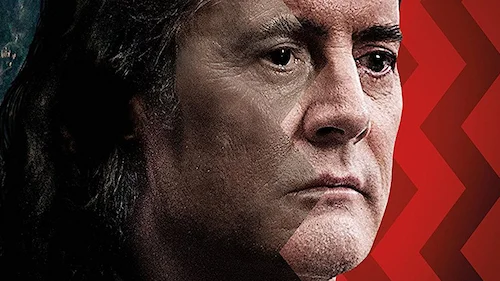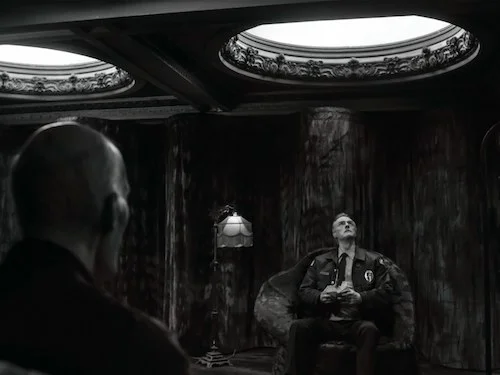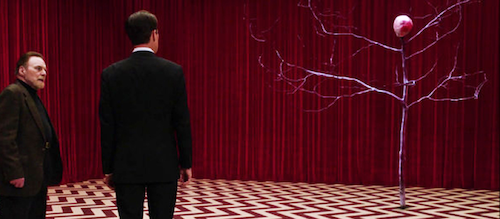Twin Peaks Week: The Return
The Return
Twenty five years later (well, technically twenty six), The Return happened. It’s been just about two years since we finally revisited the world David Lynch and Mark Frost created, and what a miasma it continued to be. After Showtime (the new networked that allowed the miniseries to take place) began to disagree with David Lynch’s ideas and the funding for the project, the possibility of this being any good was starting to become debatable. The majority of cast and crew members begged Lynch to reconsider, and Lynch finally came to an agreement with Showtime. The hope grew even stronger. It was a studio that killed Twin Peaks in season two. Lynch finally actually had an upper hand. No limitations of any sort. So many other shows have been brought back to life, only for us to reconsider why we thought they should be redone in the first place.
The Return, in my opinion, only made the series insurmountably better. Any major blemishes were ignored outright (or at least referenced in part, to at least allow these histories to exist). Any open threads were continued. Of course, this is a David Lynch project, so nothing will ever be fully understood. However, the completion Lynch wanted was finally done at his own hand. His mission to break television just got a bit stranger. Streaming exists, now. You can watch any series on any device that allows it. Lynch’s mission to challenge the comforts of the nuclear televised family continued no less, and the results were spine tingling.
Andy Brennan in the White Lodge.
The series starts with an early scene of an unknown person staring at a clear box, waiting for something to happen. He is instructed to wait until a strange phenomenon takes place, and then he can take notes and report his findings. This is us. This is us waiting for Twin Peaks to come back with our empty shell of a television, and the patience of a saint knowing that the wait is almost over. We are glued to our devices, as if our lives depend on it. This show (or any show we devote ourselves to) is our life. We need this.
The strange being ends up murdering the employee (and his romantic partner); it’s as if this program can do harm to us, either by missing our expectations, or by shattering our comfort zones. Either way, Lynch made The Return hyper aware (in the same way Mark Frost made The Final Dossier relevant to the state of the world now). He flat out has a scene of a caretaker sweeping the Roadhouse for what feels like ten minutes. The molds of a television show are going to be tested. That’s why I love the infamous sweep scene. This shouldn’t exist on television, and yet here we are. Between this, and Lynch knowingly nodding James Hurley (through a compliment from Shelly Johnson, and his own song being performed), parts of The Return are an awareness of the audience waiting to eat up this show: internet fanbases, and the uninformed of the original show. It’s weird, and no one involved cares. It’s pure bliss.
Albert, Gordon, and Diane.
Twin Peaks itself is decaying. It’s still familiar, but it’s shifted. It’s older. It’s tainted by a ghostly aura. Sheriff Truman is sick and replaced by his brother. Otherwise, mostly everything else is exactly the same, as if these people have been locked in place. The television was off. They had nowhere to go. They just festered in the exact same spots for over twenty five years. The police station. The RR Diner. The Great Northern Hotel. They’re all the same. They just operate marginally differently. Dr. Jacoby has become a conspiracy nut, which only makes sense, given his older brother’s involvement with sensationalist writing (as seen in The Secret History of Twin Peaks).
Despite all of this, there is no sign of Audrey Horne. We later barely see that she is locked away somewhere, and her mind is not all there. Most episodes of the series finish with a celebrity performance at the Roadhouse (Chromatics, “The” Nine Inch Nails, and even Julee Cruise make an appearance, amongst others). When Audrey finally ends up going to the Roadhouse (after many episodes of debating whether or not she should go), she reaches her realization that she is not actually there; the live band begins to play in reverse. Was the Roadhouse Audrey’s mind this entire time? Was this longing for Twin Peaks and the joys she sought from it her coping mechanisms while locked away in isolation (as proven by The Final Dossier)?
“We live inside a dream”.
Time is not a fixed element in Twin Peaks. It’s proven by Audrey’s multi-episode argument, by Dougie playing catch with his son somehow in between his Mitchum brothers fiasco, when Ed stares blankly through the gas station window, and so many other moments. In The Return, everything is a haze. You see, the main objective of this miniseries is for Special Agent Dale Cooper (initially stuck in the Black Lodge) to return to Twin Peaks. His tulpa has become Dougie: a lazy, cheating sloth of a father that lives in Las Vegas. Evil Cooper (his physical body on Earth, possessed by Bob) is a mastermind criminal that is constantly on the run. Cooper ends up taking on Dougie’s physical body, but his mind has not snapped into place. He operates on auto pilot; only specific triggers seem reactionary to him. Otherwise, he is a brain dead robot: a shell of the character people have been hankering decades for.
At the end of the trip, Cooper (now back to his iconic shape) has saved the day (with some help). His face overlays the scenario, and the clock on the wall begins to act up. “We live inside a dream”, declares the giant Cooper face. Is all of this fake? Did Cooper ever even leave the Black Lodge? Was all of this his interpretation of what was potentially going on in his favourite town while he was locked away forever? For me, I say not quite. When Cooper saves Laura Palmer by connecting with Phillip Jeffries, her body vanishes. She did not die, and she may not have even existed (a certain confusion surrounding it all is present in The Final Dossier). However, Cooper cannot save Laura for good, as she is sucked away on the day of her death regardless. There just isn’t a corpse to brand the evening. Cooper and Diane (played brilliantly by Laura Dern) travel into a new dimension. Everything looks the same, but beings have swapped places. This is Lynch’s obsession with the double coming around in full circle. We’ve reached a place where everything is the same, but all is different. Everything operates the same way, but the engineers and pilots of every device and vehicle has shifted into a different body.
He finds Carrie Page: Laura Palmer in this timeline. She doesn’t know him, but she has found herself in a bit of trouble (what appears to be a murder). When she is brought back to Washington (in what seems like an evening; again, time plays against the rules here), something triggers her mind: a distant voice calling for Laura. She shrieks, and the dream ends (for us). Before this final moment of the series, we hear Cooper asking “what year is this?”, as if he ended up in Twin Peaks at the wrong time. Not so. You ended up in Twin Peaks in a new entity altogether. Saving Laura Palmer, as Laura Palmer, is virtually impossible. Despite his ability to break realities (with what is arguably the greatest detective work ever; who else would travel through realms like this to solve a case?), Cooper’s attempts are futile. Twin Peaks (as he experienced it) still exists. It just will continue to do so without him.
The Black Lodge in The Return.
We start the series with visions of both the Black Lodge, and the White Lodge (the alternative that we get more familiar with in this revival). These weren’t events that happened before the series. Who knows when they happened. Again, time is non existent here. We end the series with a haunting image of Laura Palmer whispering in Cooper’s ear in the Black Lodge. He did leave, but he never did leave. He is continuously locked in this hell for the rest of eternity. The price of trying to rescue the real death of a real person, was the rendering of the two of them non existent. “I died, yet I live” Laura says in the first parts of the series. In the Black Lodge (and arguably the White Lodge), there is no finality. If you can enter worlds through electrical outlets or by hidden portals in forests, there simply isn’t a definitive way things work here.
The sad thing is, there is a story we will never ever know. We are seeing the latest “return” Cooper had that succeeded and failed (Laura Palmer disappeared from her timeline and couldn’t be killed, but she couldn’t be saved for good). Think about it. We see Sarah Palmer’s tortured soul the entire miniseries. We see her as a child being possessed on what seems like the happiest moment of her life (the unknown girl is confirmed to be Sarah Palmer in The Final Dossier). We see the golden orb sent to Twin Peaks from the White Lodge. This is the current timeline, still. We see the inevitability of it all. Laura disappears, and Sarah is still having a breakdown. This isn’t the true end, because there cannot be one.
Sarah Palmer as a child.
The majority of The Return doesn’t even take place in Twin Peaks. It’s a journey for all resemblances of Dale Cooper to converge at one meeting point (the town), through a whole slew of existences. There are so many new faces stretched across America in this run. There are many depictions of horror (William Hastings getting wrapped up in his own Leland nightmare), the American dream (Janey-E and her son wanting Dougie Jones to be the ideal husband and father he can be), and chaos (pick whichever gang or underworld you want to focus on). There are many damaged people: a Diane tulpa, who was raped by Evil Cooper (and similarly, Richard Horne, Audrey’s son conceived by Evil Cooper against her will), and the heartbroken citizens of the town that just never got it together.
The Return is a return in many ways, and it isn’t. We have Twin Peaks back, but it’s a very different animal. Slower, more cynical, and way more experimental (if that was even possible, before). These are the same characters, yet some are way older, some are gone, some aren’t even real (they are clones), and some don’t technically exist. This is a television show, but it’s also an eighteen hour long film. Everything and nothing are certain at the same time. This rings true with the dream states, time lines, realities, and relationships. The Return is a full realization of a dream Lynch and Frost had, and it’s so damn beautiful to witness. We wrap up the season — and potentially the series — on a major question: what next? If nothing came after this conclusion, it would still be glorious. We are still hungry. For now, Twin Peaks is in the position where it can stay finished or it can start back up again. I kind of hope it stays in this limbo. It’s a statement on televised realities, our connection to them (as if we exist in a new realm), and the manipulations of what a televised civilization can be. The Return is a success, and an elevation of what Twin Peaks was attempting to begin with.
Join us tomorrow for the final Twin Peaks Week event: We will rank ten of the best episodes in all of Twin Peaks.
Andreas Babiolakis has a Masters degree in Film and Photography Preservation and Collections management from Ryerson University, as well as a Bachelors degree in Cinema Studies from York University. His favourite times of year are the Criterion Collection flash sales and the annual Toronto International Film Festival.








